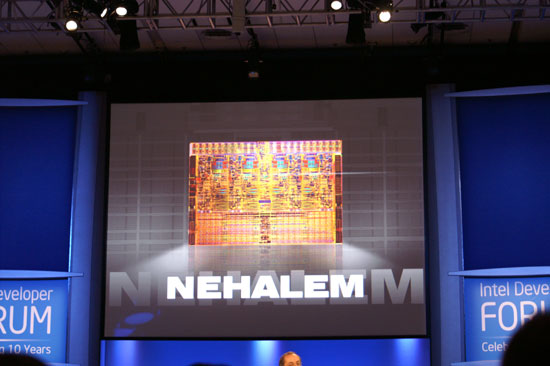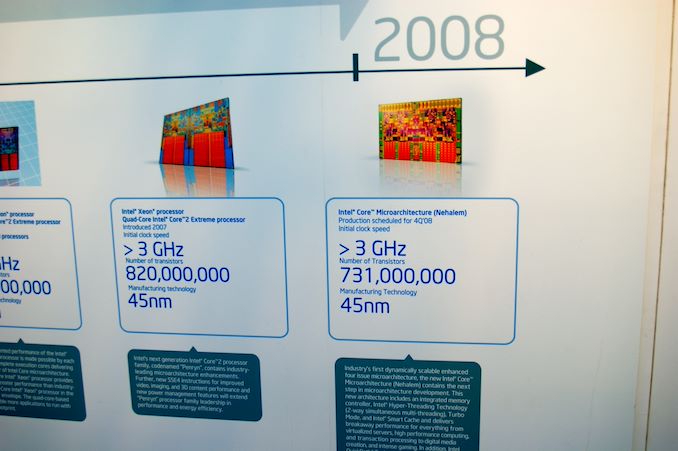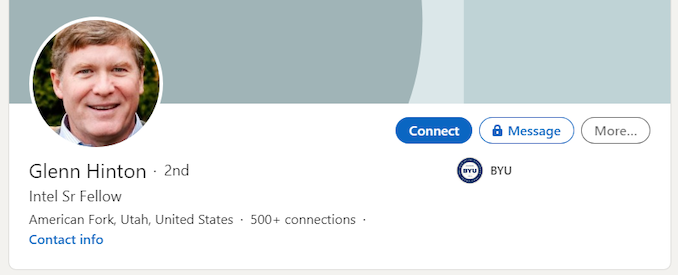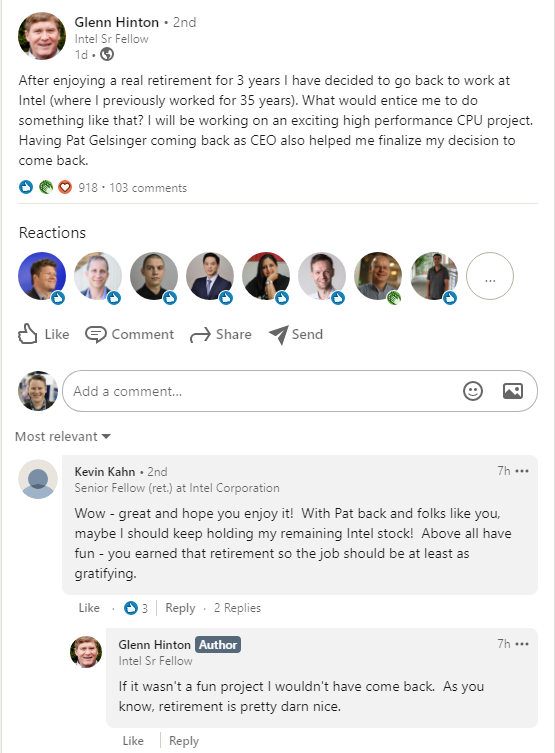New Intel CEO Making Waves: Rehiring Retired CPU Architects
by Dr. Ian Cutress on January 21, 2021 5:05 AM EST- Posted in
- CPUs
- Intel
- Nehalem
- Pat Gelsinger

We’re following the state of play with Intel’s new CEO, Pat Gelsinger, very closely. Even as an Intel employee for 30 years, rising to the rank of CTO, then taking 12 years away from the company, his arrival has been met with praise across the spectrum given his background and previous successes. He isn’t even set to take his new role until February 15th, however his return is already causing a stir with Intel’s current R&D teams.
News in the last 24 hours, based on public statements, states that former Intel Senior Fellow Glenn Hinton, who lists being the lead architect of Intel’s Nehalem CPU core in his list of achievements, is coming out of retirement to re-join the company. (The other lead architect of Nehalem are Ronak Singhal and Per Hammerlund - Ronak is still at Intel, working on next-gen processors, while Per has been at Apple for five years.)
Hinton is an old Intel hand, with 35 years of experience, leading microarchitecture development of Pentium 4, one of three senior architects of Intel’s P6 processor design (which led to Pentium Pro, P2, P3), and ultimately one of the drivers to Intel’s Core architecture which is still at the forefront of Intel’s portfolio today. He also a lead microarchitect for Intel’s i960 CA, the world’s first super-scalar microprocessor. Hinton holds more than 90+ patents from 8 CPU designs from his endeavors. Hinton spent another 10+ years at Intel after Nehalem, but Nehalem is listed in many places as his primary public achievement at Intel.
On his social media posts, Hinton states that he will be working on ‘an exciting high performance CPU project’. In the associated comments also states that ‘if it wasn’t a fun project I wouldn’t have come back – as you know, retirement is pretty darn nice’. Glenn also discloses that he has been pondering the move since November, and Gelsinger’s re-hiring helped finalize that decision. His peers also opine that Glenn is probably not the only ex-Intel architect that might be heading back to the company. We know a few architects and specialists that have left Intel in recent years to join Intel's competitors, such as AMD and Apple.
There are a few key things to note here worth considering.
First is that coming out of retirement for a big CPU project isn’t a trivial thing, especially for an Intel Senior Fellow. Given Intel’s successes, one would assume that the financial situation is not the main driver here, but the opportunity to work on something new and exciting. Plus, these sorts of projects take years of development, at least three, and thus Glenn is signing on for a long term despite already having left to retire.
Second point is reiterating that last line – whatever project Glenn is working on, it will be a long term project. Assuming that Glenn is talking about a fresh project within Intel’s R&D ecosystem, it will be 3-5 years before we see the fruits of the labor, which also means creating a design aimed at what could be a variety of process node technologies. Glenn’s expertise as lead architect is quite likely applicable for any stage of an Intel R&D design window, but is perhaps best served from the initial stages. The way Glenn seems to put it, this might be a black-ops style design. It also doesn't specify if this is x86, leaving that door open to speculation.
Third here is to recognize that Intel has a number of processor design teams in-house and despite the manufacturing process delays, they haven’t been idle. We’ve been seeing refresh after refresh of Skylake lead Intel's portfolio, and while the first iterations of the 10nm Cove cores come to market, Intel’s internal design teams would have been working on the next generation, and the next generation after that – the only barrier to deployment would have been manufacturing. I recall a discussion with Intel’s engineers around Kaby Lake time, when I asked about Intel’s progress on IPC – I requested a +10% gen-on-gen increase over the next two years at the time, and I was told that those designs were done and baked – they were already working on the ones beyond that. Those designs were likely Ice/Tiger Lake, and so Intel’s core design teams have been surging ahead despite manufacturing issues, and I wonder if there’s now a 3-4 year (or more) delay on some of these designs. If Glenn is hinting at a project beyond that, then we could be waiting even longer.
Fourth and finally, one of the critical elements listed by a number of analysts on the announcement of Gelsinger’s arrival was that he wouldn’t have much of an effect until 3+ years down the line, because of how product cycles work. I rejected that premise outright, stating that Pat can come in and change elements of Intel’s culture immediately, and could sit in the room with the relevant engineers and discuss product design on a level that Bob Swan cannot. Pat has the opportunity to arrange the leadership structure and instill new confidence in those structures, some of which may have caused key architects in the past to retire, instead of build on exciting projects.
As we can see, Pat is already having an effect before his name is even on the door at HQ.
Today is also Intel’s end-of-year financial disclosure, at 5pm ET. We are expecting Intel’s current CEO, Bob Swan, to talk through what looks to be another record breaking year of revenue, and likely the state of play for Intel's own 7nm process node technologies. That last point is somewhat thrown into doubt given the new CEO announcement and if Gelsinger is on the call. It is unknown if Gelsinger will participate.
Related Reading
- Intel Appoints Pat Gelsinger as New CEO, From Feb 15th
- An Interview with Intel CEO Bob Swan: Roundtable Q&A on Fabs and Future
- Robert Swan Named CEO of Intel













112 Comments
View All Comments
mode_13h - Saturday, January 23, 2021 - link
But that's so long ago... are you certain that design cycles haven't shortened, since then?ThereSheGoes - Thursday, January 21, 2021 - link
I'm disappointed to see AnandTech stoop to clickbait. The new CEO hasn't arrived at Intel yet (not until next month), so he did not have any direct role in hiring this engineer. As noted in the article itself, the engineer has been in talks with Intel since November, long before the new CEO arrived. Also, the title says "architects" when in fact this is a single architect. These problems also make the asserition that the new CEO is 'making waves' highly inaccurate.lipscomb88 - Thursday, January 21, 2021 - link
I think it's reasonable to assume though he hasn't technically started yet, that the new ceo isn't passively awaiting that date by doing nothing. Even his hiring itself was a contributing factor in the fellow returning to Intel, as the article also states. I don't think your argument that this is clickbait is reasonable.ThereSheGoes - Thursday, January 21, 2021 - link
This is rather simple:1.) The engineer was in negotiations long before CEO announcement and arrival
2.) CEO hasn't started working yet, thus had no direct involvement in hire
3.) Architect, not architects
4.) A singular architect is certainly not 'making waves' in a company with more than 50,000 engineers.
phr3dly - Thursday, January 21, 2021 - link
All due respect:* These people talk. It's *quite likely* that both Hinton and Gelsinger knew of each other's intentions. Gelsinger probably would have returned without Hinton, but it wouldn't surprise me at all that Gelsinger returning sealed the deal for Hinton. It also wouldn't surprise me if Gelsinger has put out feelers to other former Intel folk.
* A single architect absolutely does 'make waves'. Keller certainly made waves when he joined Intel. Not sure what his real impact ended up being, but waves were made. Likewise Raja. Hinton has a long history with Intel engineers. He is well known and well respected.
* A big complaint internally at Intel in recent years has been that upper management isn't listening to its technologists. Who knows, this may even be one reason Murthy is no longer there...... There is every reason to believe that Gelsinger will correct that problem, and I'd imagine that factors heavily into Hinton's willingness to return.
ThereSheGoes - Thursday, January 21, 2021 - link
All due respect - none of your statements disputes the fact that the title is factually inaccurate - i.e., clickbait.lmcd - Thursday, January 21, 2021 - link
The posted LinkedIn comment literally says Gelsinger is why Hinton is back, from Hinton's own fingers. What more do you want? Please. RTFA.Ian Cutress - Thursday, January 21, 2021 - link
Thanks for the backup.Gelsinger mentioned Hinton explicitly in the financial call today as bringing the talent back to Intel. He's also had time to peer into Intel's 7nm data and projections and make some conclusions on it - Feb 15th is more a date for Bob being out of the door than anything else. We're currently in transition, and Gelsinger has had strong words to say already.
Also, Hinton's own Linkedin thread mentions other engineers returning or potentially returning on this news.
mode_13h - Saturday, January 23, 2021 - link
> Keller certainly made waves when he joined Intel. Not sure what his real impact ended up being, but waves were made. Likewise Raja.How do you know? And if you're not sure about the impact, then what do you mean by "waves"? Do you just mean that we heard it being reported? That's somewhat circular reasoning.
quadibloc - Thursday, January 21, 2021 - link
Intel certainly should avail itself of the best processor design talent possible, but this isn't the major issue it faces. The major issue it faces is getting its fabs up to speed on the 10nm and 7nm processes. Outsourcing to TSMC, however attractive that might have seemed a year ago, is now being proved to be a chimera by the shortages of AMD products. Intel products that no one can get their hands on aren't going to help it recover in the competition with AMD.